Aside from grand mansions, the province of Iloilo1 offers historical and beautiful churches to visit. I am blessed to have visited one of them – Miagao Church.
Allow Tita S to tell you a dozen facts about Miagao Church:
1. Miagao Church, or the Santo Tomas de Villanueva Parish Church, is a Roman Catholic church located in the town of Miagao2, in the province of Iloilo1, in the Western Visayas Region3 of the Philippines, consecrated in 1581 and founded in 1731 by Spanish Augustinian missionaries.
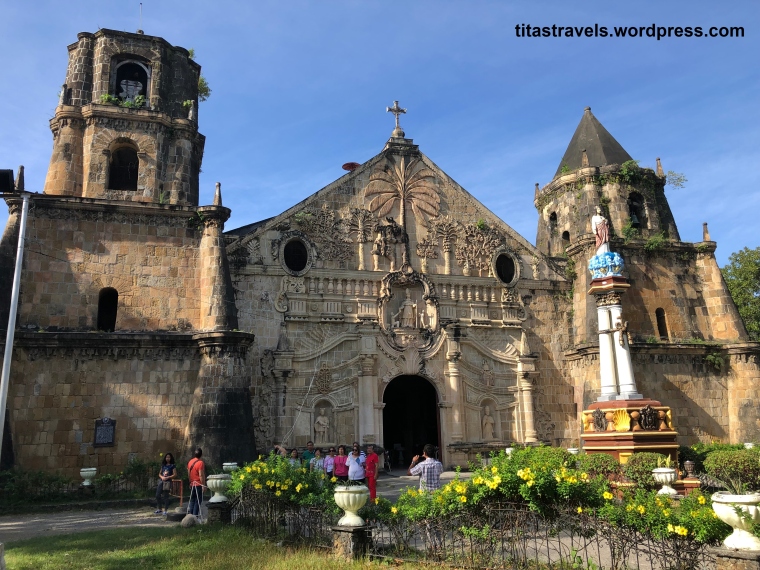

2. It was declared as a UNESCO World Heritage Site4 on December 11, 1993, together with San Agustin Church in Manila, Nuestra Señora de la Asuncion Church in Santa Maria, Ilocos Sur, and San Agustin Church in Paoay, Ilocos Norte, under the collective title Baroque Churches of the Philippines, a collection of four Baroque Spanish-era churches in the Philippines. See a related post: Seniors, Now You Know: WHAT ARE THE WORLD HERITAGE SITES IN THE PHILIPPINES?

3. This church is dedicated to Saint Thomas of Villanova (1488 – 1555), a Spanish friar of the Order of Saint Augustine, who was a noted preacher and religious writer of his day. He became an archbishop who was famous for the extent of his care for the poor of his See. He is also called Saint Thomas of Villanueva, named after Villanueva de los Infantes, a municipality in the province of Ciudad Real, Castile-La Mancha, in Spain, where he grew up and was educated. He was canonized on November 1, 1658 by Pope Alexander VII.
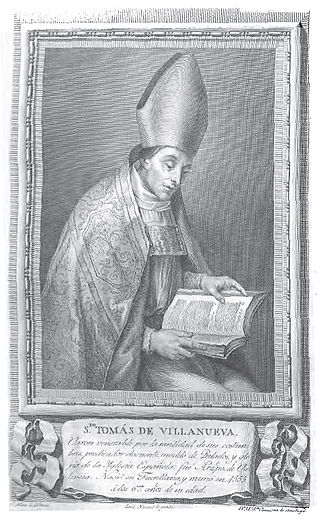
Old master print of St. Thomas in Portraits of Illustrious Spaniards (Madrid, 1791) – https://en.wikipedia.org/wiki/Thomas_of_Villanova#/media/File: Tom%C3%A1s_de_Villanueva.jpg
4. The current location of this church is at the highest point of the town of Miagao2 to guard against invaders, with the first building constructed in 1787 and completed in 1797. After severe damage during the Spanish Revolution in 1898, a fire in 1910, World War II, and an earthquake in 1948, the current church is the third church built since it was founded in 1731. It underwent restoration in 1960 and was completed in 1962.
5. It was declared a National Shrine5 through Presidential Decree No. 260, along with other shrines, monuments and landmarks, by President Ferdinand Marcos on August 1, 1973.
6. It has a Baroque Romanesque architectural style. This fortress-looking church has thick walls with sturdy pillars, large towers, and decorative arcading of semi-circular arches in windows and doorways.

The barrel vault concept is used in the ceiling, from the entrance of the church up to the altar, with antique hanging chandeliers over the pews. The church has also earned the distinction of being one of the best examples of Baroque churches in the country.6

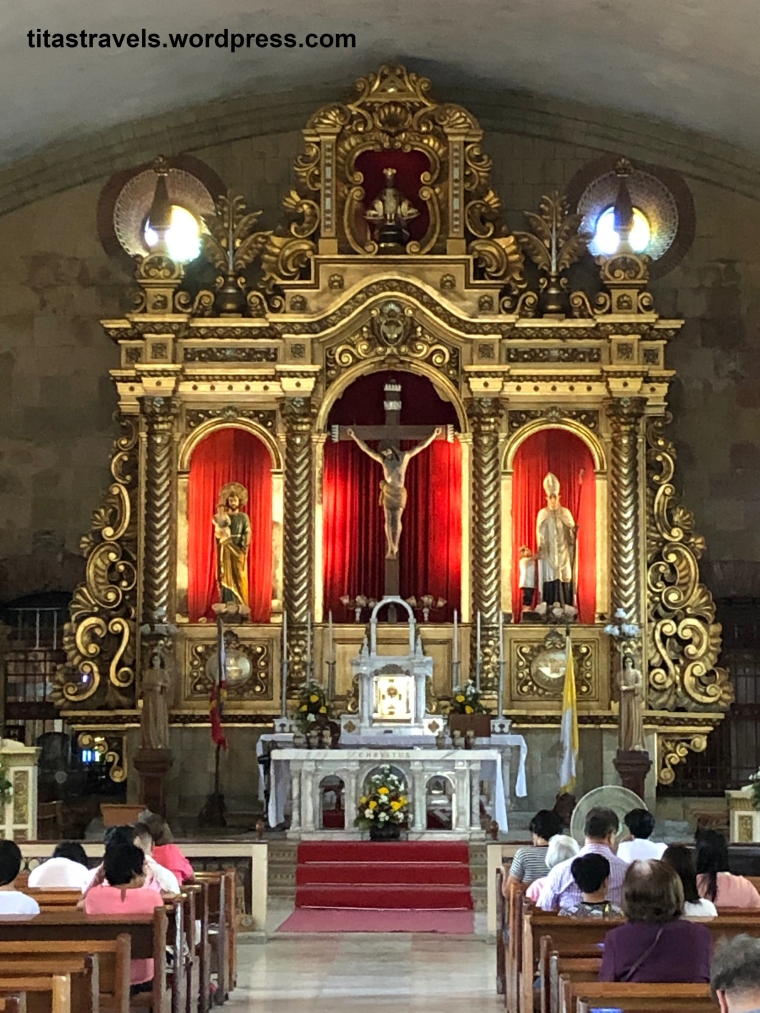
7. Its unique ochre color is due to the materials used in construction – adobe, egg whites, coral and limestone.
Yes, egg whites, dearest readers! The coral was pulverized and formed into a durable mortar, mixed with natural lime as well as egg whites as emulsifier. Inquisitive readers, you might ask, what do they do with all the egg yolks? Obviously, these are not thrown away. Instead, the egg yolks were used to make wonderful sweets and desserts, like yemas and flans!7
During my January 2020 visit, I noticed the restoration made in this church, colored ochre too.
8. The church’s foundation is 6 meters deep and the massive stone walls, 1.5 meters thick, are intensified through the use of 4-meter thick setback buttresses as protection against the Moro8 invaders, as stipulated under Royal Decree 111 of 1573 (Law of the Indies)9. The Moros repeatedly invaded Miagao2 sometime during the middle of the 18th These features fortified the church, and with its location at the highest point of the town, and reportedly, secret passages, this church became so secure, almost like a fortress, thus it was sometimes referred to as the Miag-ao Fortress Church.
9. Its facade consists of an ornately decorated bas-relief in the middle of two huge watchtower belfries on each side. The unique bas-relief is a mixed influence of Medieval Spanish, Chinese, Muslim and local traditions and elements. A prominent part of the facade is a large coconut tree which reaches almost the apex. An integral part of the Philippine landscape, the coconut tree is depicted here as the tree of life to which St. Christopher10, dressed in local and traditional clothing, clings on to, as he carries the Child Jesus on his shoulder. The rest of the facade features the daily life of the people of Miagao2 in their native dress during the time, including native flora (e.g., coconut, palm tree and papaya) and fauna.
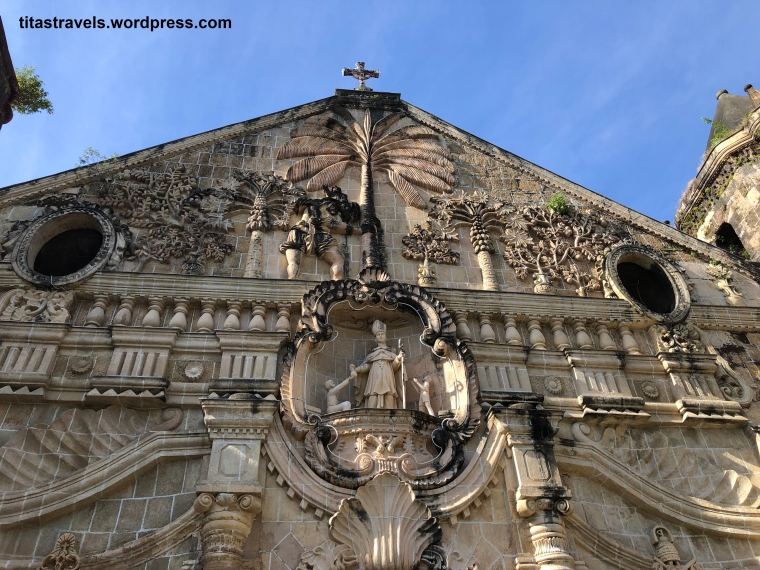
I could not help but admire the fusion of four cultures in the bas-relief, quite unique indeed! No wonder Miagao church was recognized as a UNESCO World Heritage Site4!
10. Above the wooden door entrance, at the center of the facade, just below the image of St. Christopher10, is a carved image of the town’s patron saint, St. Thomas of Villanueva. At each side of the door are the images of St. Henry of Bavaria11 on the left and Pope Pius VI12. Above these images are their respective coats-of-arms.
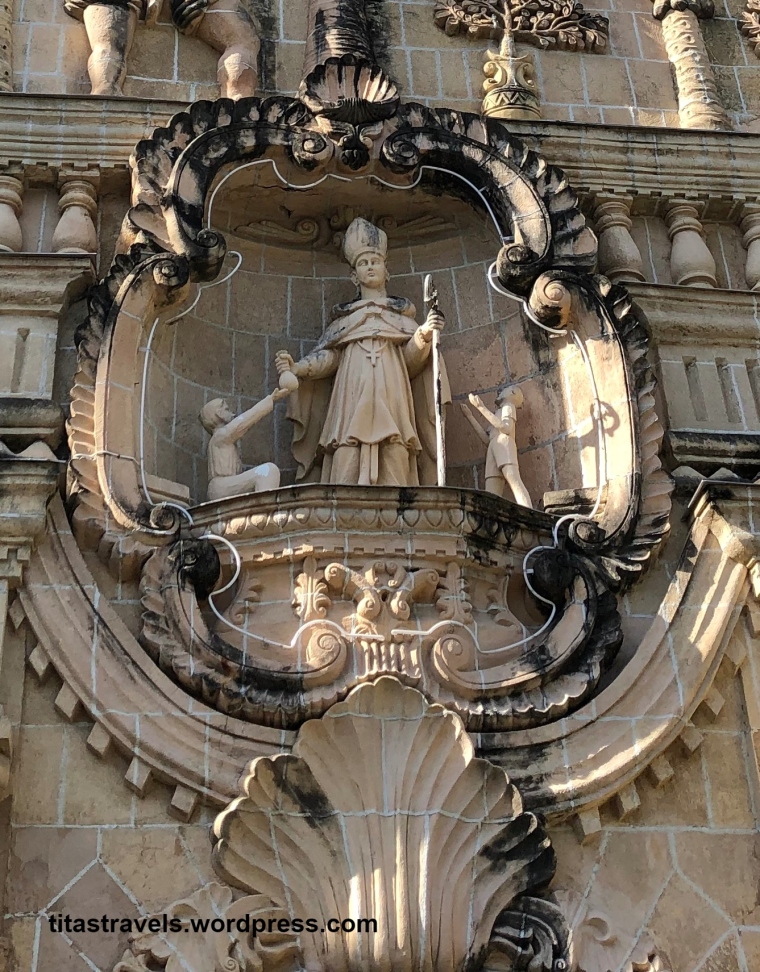
11. The two huge unequal bell towers are directly attached to the main church to serve as watchtowers in defending the town against Moro invasions then. These have two different designs since they were commissioned by two different priests. On the left side is the older belfry, the taller west belfry, with four levels. Originally, the east belfry was constructed with only two levels. It was in 1830 when Father Francisco Perez decided to add another story to the east belfry. Until now, the east belfry (three levels) is one level shorter than the west belfry (four levels).
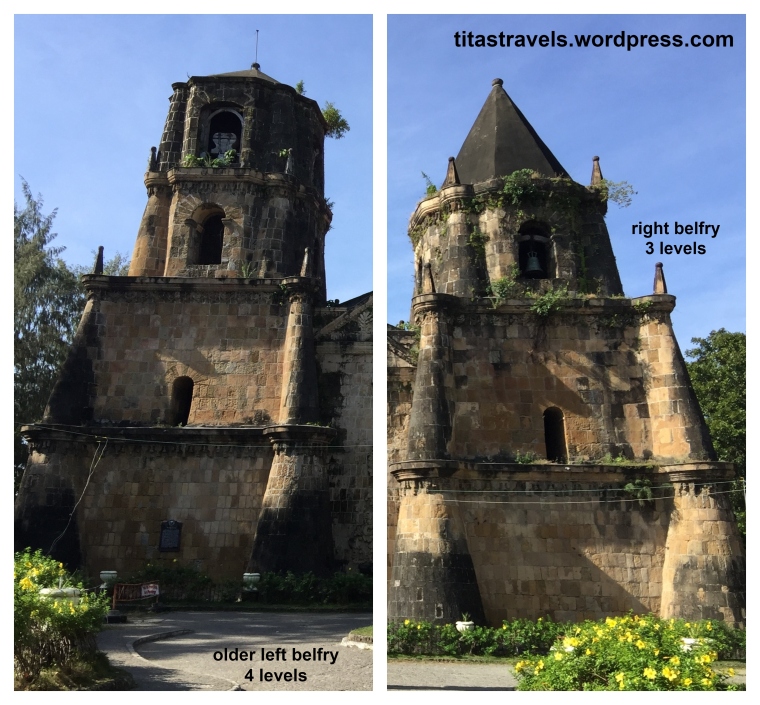
I personally found the uneven and different bell towers to be interesting – creating a unique architectural feature, and adding to the charm of Miagao Church!
12. The original late 1790s images of St. Thomas of Villanova can also be found enclosed in a glass case in the rear side of the church. Unfortunately, I did not have time to go to this part of the church.


To summarize, this National Shrine and UNESCO World Heritage Site3 church is worth the visit, what with its history as well as its unique architecture with local designs and features that I described above. And why not set a schedule to hear mass in this historical church during your visit, like we did? Just check the schedule of masses with your tour guide.
The information was obtained from the Wikipedia page “Miagao Church”13 and “Miagao”14.
Did you find this post informative? I would like to hear from you regarding your visit to Miagao Church.
See other interesting places through other posts in this category and other categories of SCapades, Pinoy Delights, and Smart Travelers – Foreign Travelers Ask, Now You Know, and Say, Say, Say. Happy reading, and I hope that you will appreciate what I shared and some of the featured destinations will be part of your future travel plans!
Do share this post with your Facebook friends, follow me by clicking on the bottom right corner of your device, and do not forget to like this post. Thank you.
– – – – – – – – – – – – – – – – – – – – – – – – – –
The following terms are defined for interested readers, especially those with “Senior-Moments”, not familiar with the Philippines, and those too busy or lazy to Google such terms:
1Iloilo is a province located in the Western Visayas Region3 of the Philippines, founded in 1566. It occupies the central and eastern sections of Panay Island15, bordered by the province of Antique to the west, Capiz to the north, the Jintotolo Channel to the northeast, the Guimaras Strait to the east, and the Iloilo Strait and Panay Gulf to the southwest. Its capital is Iloilo City16. It consists of 42 municipalities and two cities (Iloilo City and Passi City). The information was obtained from the Wikipedia page “Iloilo”.17 You may visit its website: www.iloilo.gov.ph
2Miagao, also written as Miag-ao, is a coastal town in the province of Iloilo1 in the Western Visayas Region3 of the Philippines, politically subdivided into 119 barangays. This first-class municipality is considered the “Onion Capital of the Visayas”. After the recognition of the Miagao Church as a UNESCO World Heritage Site4, the entire town was inscribed as a UNESCO World Heritage City18 and became a member of the Organization of World Heritage Cities (OWHC)19.
3Western Visayas is an administrative region in the Philippines, also known as Region VI, with a land area of 20,794.18 km2 (8,028.68 sq.mi.). It consists of 6 provinces (Aklan, Antique, Capiz, Guimaras, Iloilo1 and Negros Occidental), 2 highly urbanized cities (Bacolod City and Iloilo City15), 14 component cities, 117 municipalities, and 4,051 barangays. It is considered the most populous region in the Visayas. The information was obtained from the Wikipedia page “Western Visayas”.20
4A World Heritage Site (WHS) is a unique landmark, or geographically and historically identifiable place, which is selected by the United Nations Educational, Scientific and Cultural Organization (UNESCO) as having cultural, historical, scientific, physical or other form of significance, and is legally protected by international treaties. The information was obtained from the Wikipedia page “World Heritage Site”.21 See my post about the WHSs in the Philippines – (place link here)
5A national shrine is a Catholic church, or other sacred place, that has met certain requirements and is given this honor by the national episcopal conference22 to recognize the church’s special historical, cultural and religious significance. There are 26 national shrines in the Philippines, and Miagao Church in Iloilo is one of them. The information was obtained from the Wikipedia page “National shrine”.23
6https://business.inquirer.net/238620/church-hopping-iloilo#ixzz6C2oYj4Iq
8The collective term Moro people, or Bangsamoro people, refers to the 13 Islamized ethnolinguistic groups of Mindanao, Sulu and Palawan: Badjao, Iranun, Jama Mapun, Kalagan, Kalibugan, Maguindanao, Maranaw, Molbog, Palawanon, Sama, Sangil, Tausug and Yakan.
They form the largest non-Christian majority population in the Philippines, which is about 5 million people. Most Moros are followers of Sunni Islam of the Shafi’i madh’hab. The Muslim Moros originally had an independent state known as the Sulu Sultanate, which once exercised sovereignty over the present-day provinces of Basilan, Palawan, Sulu, Tawi-Tawi, the eastern part of the Malaysian state of Sabah (formerly North Borneo), and North Kalimantan in Indonesia.
Today, the Moro people mostly live in southwest Mindanao, Sulu and Basilan. Small communities can also be found in most large modern cities of the Philippines, including Manila, Cebu, and Davao. Some emigrated to Malaysia, Indonesia, and Brunei in the late 20th century due to the Moro conflict in Mindanao.
The information was obtained from the Wikipedia page “Moro people”.24
9The Law of the Indies refers to the entire body of law promulgated by the Spanish crown during the 16th, 17th, and 18th centuries, for the government of its colonies outside Europe.25
10St. Christopher (unknown – c.251) is widely known as the patron saint of travelers (especially long distances) since legend tells that he carried a child, who was unknown to him, across a river before the child revealed himself as Christ. But, dearest Seniors, did you know that he is also revered by athletes, mariners, ferrymen, archers, bachelors, boatmen, soldiers, bookbinders, fruit dealers, gardeners, market carriers, motorists, drivers, sailors, surfers, transportation workers, and mountaineers, and is recognized as well as the protector against lightning, pestilence, epilepsy, floods, storms, and toothache? Wow, so many! The information was obtained from the Wikipedia page “St. Christopher”.26
11St. Henry of Bavaria (973 – 1024), also known as St. Henry the Exuberant, was the son of Duke Henry II, Duke of Bavaria, and Gisela of Burgundy. Through his father, he was grandson of Henry I, Duke of Bavaria, and the great-grandson of King Henry I of Germany. By his mother, he was the grandson of King Conrad I of Burgundy, and the great-grandson of King Rudolf II of Burgundy. He was canonized in July 1147 by Pope Bl. Eugenius III, and is the patron saint of the city of Basel, Switzerland.
He became an oblate of the Benedictine Order, and today, is venerated within the Order as the patron saint of all oblates, along with St. Frances of Rome. He was crowned by the Pope as the Holy Roman Emperor (1014 – his death in 1024) and was the last member of the Ottonian dynasty of emperors as he had no children. He reigned as Duke of Bavaria from 995 – 1004, and was crowned King of Germany in 1002 and King of Italy in 1004.
The information was obtained from the Wikipedia page “Henry II, Holy Roman Emperor”.27
12Pope Pius VI (1717 – 1799), born Count Giovanni Angelo Braschi, was head of the Catholic Church and ruler of the Papal States28 from February 15, 1775 to his death in 1799. The information was obtained from the Wikipedia page “Pope Pius VI”.29
13“Miagao Church,” accessed January 17, 2020, https://en.wikipedia.org/wiki/Miagao_Church
14“Miagao,” accessed January 17, 2020, https://en.wikipedia.org/wiki/Miagao
15Panay Island is the 6th largest and 4th most populous island in the Philippines, located in the Western Visayas Region3 of the Philippines, with a total land area of 12,011 km2 (4,637 sq mi). This triangular island is located in the western part of the Visayas and consists of 4 provinces: Aklan, Antique, Capiz and Iloilo1. The information was obtained from the Wikipedia page “Panay Island”.30
16Iloilo City is a highly urbanized city on the southeastern tip of Panay Island14 in the Philippines. It was founded in 1566, recognized as a city in 1889, and as a highly urbanized city in 1979. It is the capital of the province of Iloilo1 where it is geographically situated but, in terms of government and administration, it is politically independent. It is the regional capital of the Western Visayas Region3 and the regional hub of education, healthcare, tourism, culture, industry and economy. It is also the regional center of government offices, financial institutions and government-owned and controlled corporations. It has 180 barangays. The information was obtained from the Wikipedia page “Iloilo City”.31 You may visit its website: www.iloilocity.gov.ph
17“Iloilo,” accessed January 17, 2020, https://en.wikipedia.org/wiki/Iloilo
18A UNESCO World Heritage City is a city chosen by, and a member of, the Organization of World Heritage Cities (OWHC). It must possess two characteristics: (1) It is a location of a living urban fabric of historic or contemporary interest. Its outstanding universal value has been recognized by the United Nations Educational, Scientific and Cultural Organization (UNESCO) and has been registered in the World Heritage list. (2) It has to adhere to the values of the OWHC and ensure the protection of their natural and cultural heritage. The information was obtained from the Wikipedia page “Organization of World Heritage Cities”.32
19The Organization of World Heritage Cities (OWHC) is an international non-profit, non-governmental organization of 250 cities in which sites of the United Nations Educational, Scientific and Cultural Organization (UNESCO) World Heritage list are located. It was founded in 1993 in Fez, Morocco, during the second International Symposium of World Heritage Cities. Its headquarters is located in Quebec City, Quebec, Canada. Since its first General Assembly, the member cities have been meeting every two years. The information was obtained from the Wikipedia page “Organization of World Heritage Cities”.32
20“Western Visayas,” accessed January 17, 2020, https://en.wikipedia.org/wiki/Western_Visayas
21“World Heritage Site,” accessed January 17, 2020, https://en.wikipedia.org/wiki/World_Heritage_Site
22An episcopal conference, sometimes called a conference of bishops, is an official assembly of the bishops of the Catholic Church in a given territory. It is generally defined by geographic borders, often a national one, with all the bishops in a given country belonging to the same conference, although they may include neighboring countries.33
23“National shrine,” accessed January 17, 2020, https://en.wikipedia.org/wiki/National_shrine
24“Moro people,” accessed January 17, 2020, https://en.wikipedia.org/wiki/Moro_people
25https://www.britannica.com/event/Laws-of-the-Indies
26“St. Christopher,” accessed January 17, 2020, https://en.wikipedia.org/wiki/St._Christopher
27“Henry II, Holy Roman Emperor,” accessed January 17, 2020, https://en.wikipedia.org/wiki/Henry_II,_Holy_Roman_Emperor
28Papal States refers to the series of territories in the Italian Peninsula, under the direct sovereign rule of the Pope, from the 8th century until 1870. At their zenith, the Papal States covered most of the modern Italian regions of Lazio (which includes Rome), Marche, Umbria and Romagna, and portions of Emilia. The information was obtained from the Wikipedia page “Papal States”.34
29“Pope Pius VI,” accessed January 17, 2020, https://en.wikipedia.org/wiki/Pope_Pius_VI
30“Panay Island,” accessed January 17, 2020, https://en.wikipedia.org/wiki/Panay_Island
31“Iloilo City,” accessed January 17, 2020, https://en.wikipedia.org/wiki/Iloilo_City
32“Organization of World Heritage Cities,” accessed January 17, 2020, https://en.wikipedia.org/wiki/Organization_of_World_Heritage_Cities
33“Episcopal conference,” accessed January 17, 2020, https://en.wikipedia.org/wiki/Episcopal_conference
34“Papal States,” accessed January 17, 2020, https://en.wikipedia.org/wiki/Papal_States

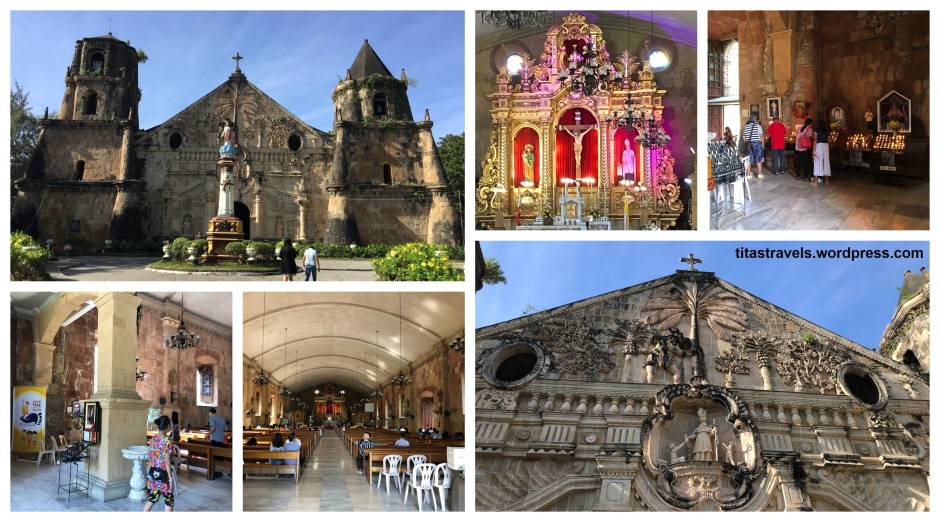
One thought on “A UNESCO WORLD HERITAGE SITE AND NATIONAL SHRINE: MIAGAO CHURCH (Miagao, Iloilo, Philippines)”